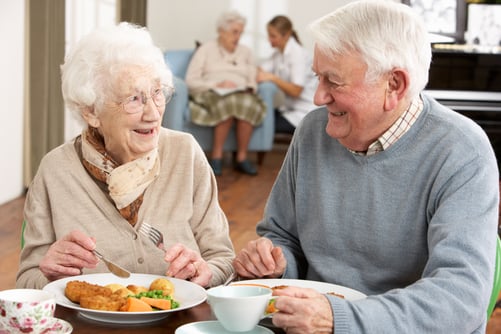.jpg?width=393&name=GettyImages-470296838%20(1).jpg) Caffeine functions as a stimulant, which means you will experience an increased heart rate, more blood flow to your body, and more oxygen to your muscles when you consume it. Here are five ways caffeine can energize your workout routine:
Caffeine functions as a stimulant, which means you will experience an increased heart rate, more blood flow to your body, and more oxygen to your muscles when you consume it. Here are five ways caffeine can energize your workout routine:
1. When it comes to caffeine and exercise, a little goes a long way.
It doesn’t matter how you ingest caffeine; its impact depends on how much you consume. Up to 400 milligrams (mg) of caffeine a day is safe for most healthy adults, but when it comes to exercise, small amounts are more than sufficient to energize your workout. (See this NIFS blog for the content in your favorite beverages and food.)
2. Caffeine can increase endurance and make your workouts feel easier.
Whether you prefer running outside or working out on the elliptical, caffeine can increase endurance up to 30 percent as well as improve your speed by 2 to 5%. With caffeine, your body’s muscle consumption of glycogen (stored energy during exercise) decreases, which forces you to use fat reserves as energy. This helps delay muscle fatigue.
3. Caffeine may not burn fat, but it helps burn more calories.
Studies show that caffeine increases fatty acids in the blood, but the body ignores the extra fats and doesn’t oxidize them. Consuming coffee before exercise helps burn up to 15% more calories for three hours afterward.
4. Timing matters—before a long workout is best.
Caffeine takes about 30 minutes to kick in, so the time you consume it matters if you want to improve your performance. Since caffeine increases endurance, it can provide a greater training effect from the workout.
5. Metabolism varies, so listen to your body.
People metabolize caffeine at different rates. Some people do not respond positively to it and can get nervous or distracted after consuming it. Drinking too much caffeine along with working out can lead to dehydration and fatigue for some people, which will decrease the ability to perform. Always listen to your body.
***
Even though consuming caffeine before a workout can improve your performance, it is important to be mindful and know your body. Don’t always rely on caffeine as an energy booster. Balance is the key.



 Lots of research has been done over the years to figuret out the best recipe for success when it comes to weight loss. Diet alone? Exercise alone? Or a combination of both? It should come as no surprise that the key for weight loss and keep it off is to combine a low-fat, lower-calorie diet with an exercise routine.
Lots of research has been done over the years to figuret out the best recipe for success when it comes to weight loss. Diet alone? Exercise alone? Or a combination of both? It should come as no surprise that the key for weight loss and keep it off is to combine a low-fat, lower-calorie diet with an exercise routine. 
 The biggest change, however, is the fact that you no longer have to think about what’s for dinner, or lunch, or even breakfast. What a joy! My husband and I have the same exact conversation every day at around 5:30pm: What’s for dinner? I don’t know. What do you want? I don’t care. What do we have lying around that I can toss together quickly? I don’t know, eggs, a salad? And we end up usually having a salad, maybe with an omelet. Easy, but sooo boring.
The biggest change, however, is the fact that you no longer have to think about what’s for dinner, or lunch, or even breakfast. What a joy! My husband and I have the same exact conversation every day at around 5:30pm: What’s for dinner? I don’t know. What do you want? I don’t care. What do we have lying around that I can toss together quickly? I don’t know, eggs, a salad? And we end up usually having a salad, maybe with an omelet. Easy, but sooo boring.
 March is National Nutrition Month! It may be time to revisit and reestablish your New Year’s diet resolutions. I wanted to pass along a basic guide to healthy eating and lifestyle habits that can also be used for weight loss.
March is National Nutrition Month! It may be time to revisit and reestablish your New Year’s diet resolutions. I wanted to pass along a basic guide to healthy eating and lifestyle habits that can also be used for weight loss. 

 Currently one-third of Americans believe they should be cutting down on gluten in their diet (based on
Currently one-third of Americans believe they should be cutting down on gluten in their diet (based on 

 It's that time for another season of candy! Actually, none of these candies would be considered healthy, but some of them are definitely better than others. Plus, with all things, it is important to keep in mind the importance of moderation, even when digging through your Easter basket. Here is a rundown of some of the most popular Easter candy choices and what you would have to do in order to burn them off.*
It's that time for another season of candy! Actually, none of these candies would be considered healthy, but some of them are definitely better than others. Plus, with all things, it is important to keep in mind the importance of moderation, even when digging through your Easter basket. Here is a rundown of some of the most popular Easter candy choices and what you would have to do in order to burn them off.* It’s easy, when walking and talking with friends or coworkers, to follow their lead and get on the elevator. Time for a change? Try being the leader and lead them toward the stairs instead of the elevator. Not only will you get where you’re going faster by taking the stairs, but you will also burn more calories throughout the day.
It’s easy, when walking and talking with friends or coworkers, to follow their lead and get on the elevator. Time for a change? Try being the leader and lead them toward the stairs instead of the elevator. Not only will you get where you’re going faster by taking the stairs, but you will also burn more calories throughout the day.